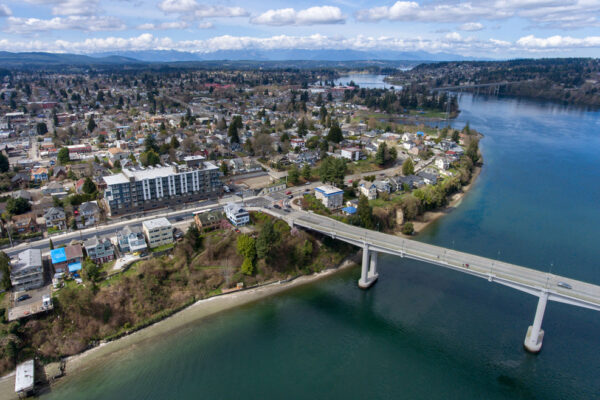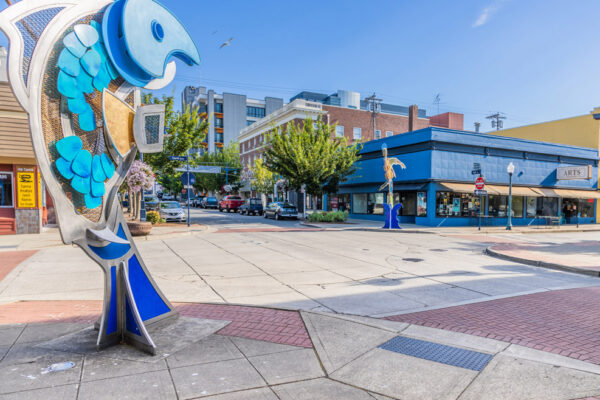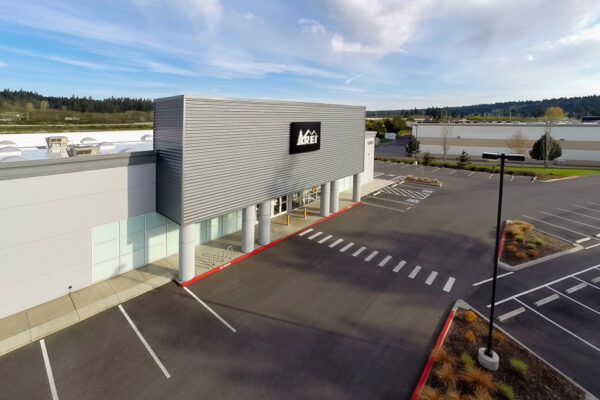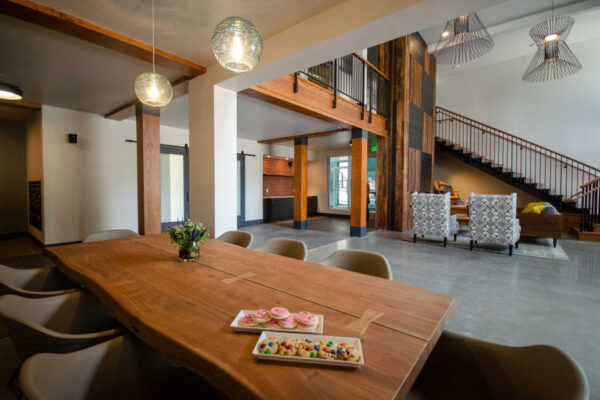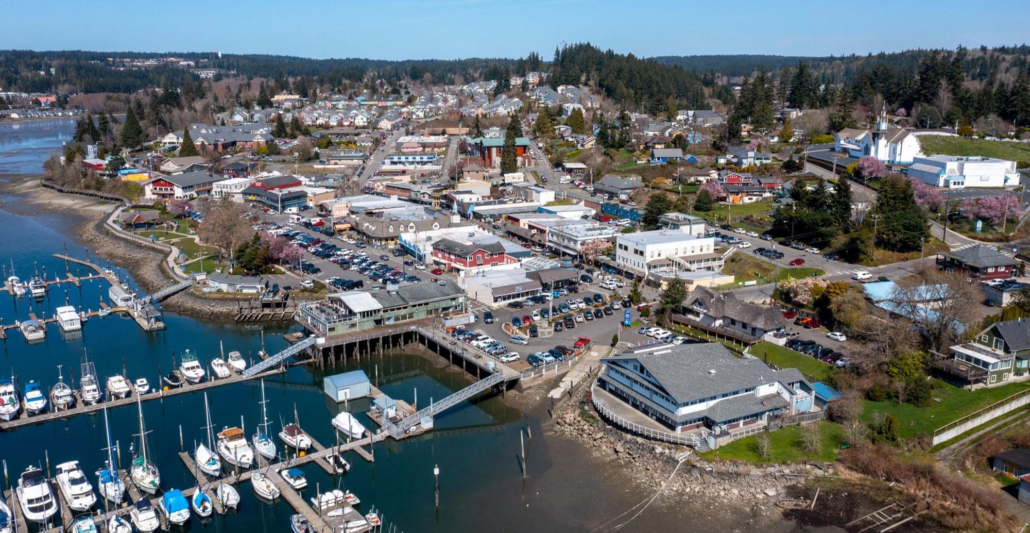With artsy towns, tangible history, and around-the-clock nature, Washington’s Kitsap Peninsula glows in more ways than one.
I rake my paddle across the water’s black surface, and electric-white fireworks erupt. Hood Canal’s bioluminescence wasn’t blue like I expected. It was more like the millions of stars we can no longer see had settled in the water — they just needed a bit of stirring up.
“Tons of places have bioluminescence,” John Kuntz, owner of Olympic Outdoor Center, tells Travel + Leisure. “You just can’t see it because of the light pollution. Here, we’re lucky that it’s still dark.”
We paddle on the Kitsap Peninsula National Water Trail, just beyond the lights of Port Gamble, Washington. Set between Seattle and the more well-known (and larger) Olympic Peninsula, Kitsap Peninsula is two hours from the Cascades and 90 minutes from the Olympics — and has spent nearly forever in the shadow of both. Bainbridge Island, the peninsula’s largest, is a well-known getaway for the Seattle elite, but it’s only recently that the rest of the world has discovered the rest of the peninsula — and how it glows.
Hood Canal wraps around Port Gamble, an old timber town that moonlights as a movie set. Modeled after East Machias, Maine, it’s all trim company homes, Victorian-esque architecture, colorful “Skittles” houses, and manicured lawns. (And, according to local lore, there’s one ghost named Gustave Engelbrecht.)
This morning, I’m biking into Port Gamble Heritage Forest Park, just seconds behind the town’s main drag. While most of Port Gamble was cut down, this spot was largely spared. Today, it offers some of the peninsula’s best hiking and biking, with 60 miles of multi-use trails and even a mountain biking ride park. Certain sections drip with moss and claim trees the size of dining room tables; others are young — and yet are still being cut. (The county bought back the land and purchasing the timber rights is the next fight.)
After a few rolling miles and plenty of stopping for photos, I bike back down to Butcher & Baker Provisions, one of my favorite Washington spots and one of my favorite cheesecake purveyors. Famous for their pimento cheese fried chicken sandwiches, amongst other things, I wait longer to eat than eating itself takes. But that’s no matter: it’s extra time to scan for Gustave.
I try to meditate (with a pastry) nearly everywhere I go. It forces me to slow down, notice the details around me, and concentrate on things like sweetness and beauty. With that in mind, my cheesecake and I head to Point No Point, a wild stretch of beach with long views across Puget Sound, to test our luck spotting orcas and sea glass.
When it’s quiet, like today, Point No Point can feel a bit somber: this is where the S’Klallam, Chimakum, and Skokomish Nations signed the Point No Point Treaty and ceded their land. Though it’s silent and serene on the sand, the waves are crashing, the gulls are crying, and Mount Tahoma looms loudly in the distance.
I munch, slowly, as is the only appropriate speed. The orcas never make an appearance, but the sea glass does, in shades of white, amber, and green.
From here, I head down the peninsula to Poulsbo, where Norwegian was the official language until 1947. Poulsbo sits on Liberty Bay, a sort of mini-fjord. Nicknamed “Little Norway,” the downtown overflows with art galleries, high-end boutiques, and the iconic Sluys Bakery, where a line regularly flows out the door. I pop in for some smells, do some window shopping, and head over to Sogno di Vino, ready to mop up some olive oil.
The cozy, fireplace-lit restaurant is next door to Hotel Scandi. It’s the town’s oldest hotel, which is now reenvisioned as a freshly designed hotel-Airbnb hybrid. There are nine rooms and shared baths, and guests can book and access rooms on their own. It’s yet another historic spot tasked with balancing eras — much like Kitsap itself.
I meet a couple of friends for lunch and a hike up Green Mountain. Though only rising to 1,700 feet, Green Mountain has 25 miles of trails and, at the top, provides its companions with views of both the Olympic and Cascade Mountains, the Seattle cityscape, and Mount Tahoma. My friends are Navy brats, and they tell me I need to check out the Navy town of Bremerton. “If Poulsbo is all about art galleries,” one says, “Bremerton is all about the art studios.”
Bremerton was and is a naval shipyard, with water whooshing in and out of all its crevices — a lower-rent town in a maze of high-dollar views. It’s one of those spots where serial entrepreneurs are opening boutiques and bakeries, thrift-store wine bars, and sticky arcades. It’s nerdy and artistic, gritty and creative. It’s got a spark that could go the way of Austin or Asheville, an underdog story awaiting its ending.
I start my night at Grumble & Wine with a half-pour of the house red and a tarot card reading. From there, I sit down to crabcakes at the bar of Hound + Bottle and meet another local, Erin, who kindly confirms all my suspicions. She tells me about locals rallying to buy the Roxy Theatre, the city’s majority-queer leadership, and the downtown’s recent push to become a capital-letter Creative District. Everyone here dreams in shades of elbow grease, it seems. As Erin puts it: “Bremerton is … not for the precious.”
I thank her for the brilliant turn of phrase, pass on dessert, and resume my exploring. I peruse pink shelves of local-made goods at Life in Mauve where literally everything is, as the name suggests, mauve; I count bakeries, making a list for later; and I eye Cafe Corvo for the morning. I wander toward the water, which waves in black and gold from the lights of the harbor. Though I can’t tell from here, it almost certainly glows.
